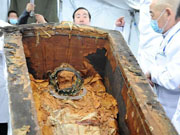Rich in copper and cobalt, Kilembe Mines in southwestern Uganda which closed in 1980s are currently in the news after the Chinese Investors started reviving them. In this story funded by the Wits China-Africa Reporting Project, Uganda’s award-winning journalist Fredrick Mugira travelled to the mines and looked at the contribution of this Chinese investment in Uganda’s development.
The knocked-knee rider of the Boda Boda motor cycle whistled as he rode. His whistling was atypical and melodious reminiscence of an exultant man. It enthralled me but I had to interrupt with a query. I was sure he heard my question because he whistled at a low tone and I sat close to him on his commercial motorcycle’s carrier as we headed to Kilembe copper mines at a fairly medium speed.
He rode steadily as he skimmed at me from his left hand shoulder and answered, “of course we have already started benefiting from the resumption of Kilembe copper mines. We transport different people from Kasese town to the mines. And when the mines start operating we shall get more passengers. We are happy we shall get more money.”
As we talked, I realized, this large-eyed and friendly rider is among thousands of people that are poised to benefit from the resumption of the now little known but once famous Kilembe Copper Mines by the Chinese company - Tibet Hima Industry Company Limited.
Production of copper and cobalt ore at the mines stopped in 1982. The mines were abandoned due to political turmoil in the neighboring Democratic Republic of Congo and a fall in copper prices.
Kilembe Mines Today
Located on the foothills of the Rwenzori Mountains, about 368 kilometers south of Kampala lay the remains of the abandoned and ghost-city like Kilembe copper mines.
The old but unique architecture of colonial buildings constructed with wood still lay barely unchanged over the course of three decades. Although some were destroyed by last year’s massive flooding in the area.
After crossing a narrow bridge on River Nyamwamba, a pebbled road leads you uphill to an area described as ”45 portal”, where the lower mines are located.
At 45 Portal, there are old metallic pipes, rail wagons and discarded equipment. A steel tower used for crashing the precious stones hangs loosely above a large heap of stones.
Four large tanks that were used to treat liquid waste from the mines sit still atop the lower mines. A rail of cable cars that carried miners in and out of the mines is stuck in one place.
With dozens of houses at the mines, Kilembe estate covers an area of about 8.5 kilometers long on the banks of River Nyamwamba and Nyalusegi stream. Life is relatively slow and the only busy place is the neighboring Kilembe Hospital due to the presence of patients and their caretakers.
The main fuel station and post office are non-functional. A few shops and business centers remain of the once thriving town. It is a city of ghosts. Many structures have barely changed over the course of decades. Colonialists would surely turn in their graves if they saw Kilembe mines today.
Kilembe Mines Buyout
Tibet Hima Industry Company Limited, a consortium of Chinese companies, is reviving copper mining in Kilembe after signing the concession agreement with the government of Uganda in 2013.
The firm is to invest 175 million USD in the mines in the first three years. They will also invest in smelting, refining and product factory development. It also plans to increase power production at the Mobuku power plant, one of Kilembe’s assets, to 12 megawatts, from 5 megawatts.
Records by the government of Uganda indicate that Kilembe has more than 4.5 million tonnes of measured unexploited copper ore.
The deputy chief executive of Tibet Hima Mining, Lu Guo told journalists in Kampala that they paid the Ugandan government a signature fee of more than 4 million USD and shall pay an annual concession fee of 1.5 million USD for the 25 years — the duration of the concession.
Job Prospects
As a direct result of this investment, Lee Quinaguo, the company’s general manager says the mines are to offer more than 3,500 job opportunities after the ongoing exploration process.
“Currently we are doing the rehabilitation and exploration process and after that, we shall start the mining and processing,” Quinaguo said before referring us to their lead consultant Tinka Kwatampora Alex.
Alex notes that exploration is taking place in the areas of Kyalumba, Ihandiro, kitholu, Muhokya, Rukooki, Bubara and Bukangara.
“According to the results so far obtained the copper that exists is economically viable and can run the company for the 25 years,” he reveals.
The company plans to renovate the mines and the houses around the mines which it inherited. This is likely to greatly change the now ghost-like Kasese mines and the neighboring communities.
“During the rehabilitation process we are also going to look at the property that we have inherited from government. We shall renovate those which are not condemned and also demolish those that have been condemned,” says Alex further insisting that, “this means jobs to Ugandans.”
Currently, up to 300 people are employed in the mines as field assistants. They are working as causal laborers among other jobs.
300 may not be a big number but it is a great contribution so far in fighting against unemployment in a country where the problem of unemployment has been described by many as a time bomb; a country where up to 62 percent of youths are jobless.
Memories of Old Kilembe Mines
At its zenith in 1970’s copper production at Kilembe was one of Uganda’s leading foreign exchange earners and a source of jobs. It employed over 6,000 workers according to Alex who has lived in Kilembe for the last 40 years.
The man who knows better the contribution of the old Kilembe Copper Mines in Uganda’s job sector is Amos George Mfitebasaze.
For over 12 years till 2002, George was the General Manager for Kilembe Mines Limited, a private company that was 99 percent owned by the government of Uganda and 1 percent owned by the King of Toro Kingdom. It is this company that maintained the mines till Tibet Hima Industry Company Limited bought the concession to run the mines.
He says at its peak in 1960s and 70s, the mines were a source of pride to Uganda; offered employment to hundreds of thousands of people from various parts of Uganda and attracted a lot of foreign exchange to Uganda.
“Even after stopping production, by 1990, the mines employed 1,200 people. By 2000 we had 600 employees,” narrates George further noting that, “if the new company succeeds, it is going to help the region and the country to develop.”
Buhikire Bwakatahwire, a social worker, lived at the mines in mid-1960s. He was by then in secondary school and stayed with his uncle who was a senior worker in the mines.
He narrates that during the 1960s, people employed in the mines lived fairly better lives.
“They had at least enough money to take their children to school; build better houses back at home and their children are right now living better lives,” notes Buhikire.
He cites an example of the Bakiga tribe in southwestern Uganda saying, “Several Bakiga migrated from Kabale district to work in the mines. They were able to get money and educate their children. This is why Bakiga people are among the highly educated Ugandans now.”
Buhikire also gives examples of extension of the railway line to Kasese to transport copper and introduction of cotton cash crop as some of the benefits that the mines took to Kasese region.
“If the old mines were able to bring all these developments to the region, then expect the new ones to more than triple them,” insists Buhikire.
Other Benefits
Revival of the mines comes with several other benefits not just employment alone.
The company’s plan to increase power production at the Mubuku power plant to 12 megawatts, from 5 megawatts means a lot to the people of Kasese. It will increase power supply to the communities living close to the mines.
Tinka Kwatampora Alex, the lead consultant for Tibet Hima Mining Co. Ltd says the company will pay royalties and other taxes as stipulated by the government in the concession agreement.
Likewise Lieutenant Colonel Dura Muhindo Mawa, the Kasese district chairperson says that the district local government and the municipality will benefit from the mines because the company will be paying local taxes.
“We have started benefiting indirectly because the hotels where they (consultants and exploration experts) are residing in Kasese town pay local service taxes and when full production starts we shall also get royalties from them,” says Mawa.
What is more interesting is that Tibet Hima Mining is also considering taking over the management of Kasese Cobalt Company Limited (KCCL), which closed down last year as a result of lack of raw materials. This is according to Lee Guo, the manager of the exploration project.
“You can’t run a cobalt plant when you don’t have raw materials. Now that we have the raw materials we are going to consider buying KCCL so that we can process our cobalt from that plant,” notes Guo.
Costs of Reviving the Mines
Reopening of the mines does not come with benefits alone. Asiimwe Wilson is a Kasese district based journalists. He says he has been covering stories of pollution from the mines and fears that the revival of these mines could mean increased pollution in the area.
But Augustine Koli, the Kasese district environment officer says there should be no cause for worry. “We are working closely with the new company in the exploration process to ensure that what is taking place is environmentally friendly,” says Augustine.
Reviving of the Kilembe copper mines after 30 years of inactivity and the benefits this will bring to Ugandans is a perfect example of what the growing Chinese Investment in Africa is contributing in the development of African countries.
Funding for coverage of this Story was provided by the Wits China-Africa Reporting Project.
 |

 Top 10 safest airlines in the world
Top 10 safest airlines in the world Bridge Worship Festival in Taijiang, SW China
Bridge Worship Festival in Taijiang, SW China  Chinese artists from Flight MH370 and their art
Chinese artists from Flight MH370 and their art Selected photos of 'two sessions'
Selected photos of 'two sessions' Most unusual taxis around the world
Most unusual taxis around the world Sweet photos of mom striking Yoga poses with daughter
Sweet photos of mom striking Yoga poses with daughter Top 10 pure beauties in showbiz
Top 10 pure beauties in showbiz Top 20 happiest cities in China
Top 20 happiest cities in China Beautiful fisherwomen in SE China
Beautiful fisherwomen in SE China History in photos: Anti-Japanese War (1937-1945)
History in photos: Anti-Japanese War (1937-1945) Female SWAT team in Chongqing
Female SWAT team in Chongqing 1,500-year-old coffin excavated from grassland in N China
1,500-year-old coffin excavated from grassland in N China Ballerinas anywhere but onstage
Ballerinas anywhere but onstage
Day|Week|Month